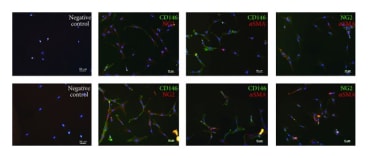Anti-MCSP [LHM 2]
Invented at Queen Mary University of London
- Datasheet
- References (10)
- Inventor Info
Info
| Catalogue Number | 151118 |
| Applications | FACS IHC IF IP WB ICC |
| Antigen/Gene or Protein Targets | Melanoma associated Chondroitin Sulphate Proteoglycan (MCSP or NG2) |
| Reactivity | Human |
| Relevance |
Monoclonal antibody against MCSP melanoma marker. Background and Research Application MCSP is a chondroitin surface proteoglycan, involved in stabilizing cell-substratum interactions during early events of cell spreading. MCSP is an integral membrane chondroitin sulphate proteoglycan expressed by human malignant melanoma cells. Anti-MCSP (LHM2) antibody is a very good marker for melanoma (>90% stained). LHM2 also stains basal cell carcinomas and subpopulation of basal keratinocytes. LHM2 can be used as a diagnostic panel for immunopathology of malignant melanoma and potential candidates for immunoimaging and immunotherapy of disseminated melanoma. Potential applications of the LHM2 antibody include use for separation/isolation of epidermal stem cells, detection of stem cells in skin biopsies or epithelial cell cultures and optimisation of culture conditions to retain epidermal stem cell population in in vitro cultures. |
| Host | Mouse |
| Immunogen | A 375P cells crude extract. |
| Immunogen UniProt ID | Q6UVK1 |
| Subclass | IgG1 kappa |
| Molecular Weight (kDa) | 240 |
| Myeloma Used | NS0 |
| Recommended Growing Conditions | DMEM + 5% FCS |
| Notes |
Production Details Purified using multi-step affinity chromatography with protein A. Storage Conditions Store at -20 degrees frozen. Avoid repeated freeze/thaw cycles. Points of Interest The originators of this antibody report that the MCSP is a cell surface marker specific for epidermal stem cells (J. Invest. Dermatol. in press). Concentration 1mg/ml as standard |
| Research Area | Adhesion, Cancer, Cell Type or Organelle Marker, Neurobiology |
References: 10 entries
Li et al. 2019. Theranostics. 9(17):5105-5121. PMID: 31410204.
Arrigoni et al. 2016. Adv Healthc Mater. 5(13):1617-26. PMID: 27191352.
Loibl et al. 2014. Biomed Res Int. 2014:395781. PMID: 24563864.
IF ICC
Somaiah et al. 2012. Clin Cancer Res. 18(19):5479-88. PMID: 22855580.
Somaiah et al. 2012. Clin Cancer Res. 18(19):5479-88. PMID: 22855580.
IHC
Kinney et al. 2012. Ann Neurol. 71(3):397-406. PMID: 22451205.
Pierce et al. 2011. Aging Cell. 10(6):1032-7. PMID: 21943306.
Ghali et al. 2004. J Invest Dermatol. 122(2):433-42. PMID: 15009727.
Kupsch et al. 1999. Clin Cancer Res. 5(4):925-31. PMID: 10213230.
Kupsch et al. 1995. Melanoma Res. 5(6):403-11. PMID: 8589614.
Add a reference
References: 10 entries
Li et al. 2019. Theranostics. 9(17):5105-5121. PMID: 31410204.
Arrigoni et al. 2016. Adv Healthc Mater. 5(13):1617-26. PMID: 27191352.
Loibl et al. 2014. Biomed Res Int. 2014:395781. PMID: 24563864.
IF ICC
Somaiah et al. 2012. Clin Cancer Res. 18(19):5479-88. PMID: 22855580.
Somaiah et al. 2012. Clin Cancer Res. 18(19):5479-88. PMID: 22855580.
IHC
Kinney et al. 2012. Ann Neurol. 71(3):397-406. PMID: 22451205.
Pierce et al. 2011. Aging Cell. 10(6):1032-7. PMID: 21943306.
Ghali et al. 2004. J Invest Dermatol. 122(2):433-42. PMID: 15009727.
Kupsch et al. 1999. Clin Cancer Res. 5(4):925-31. PMID: 10213230.
Kupsch et al. 1995. Melanoma Res. 5(6):403-11. PMID: 8589614.
Add a reference



![Image thumbnail for Anti-MCSP [LHM 2]](https://res.cloudinary.com/ximbio/image/upload/c_fit,fl_lossy,q_auto/56a3fe26-c75f-4948-87b5-2002ac268ec8.jpg)
![Image thumbnail for Anti-MCSP [LHM 2]](https://res.cloudinary.com/ximbio/image/upload/c_fit,fl_lossy,h_45,q_auto/56a3fe26-c75f-4948-87b5-2002ac268ec8.jpg)
